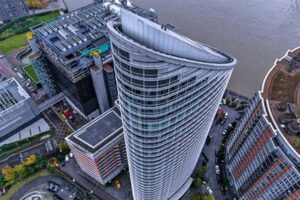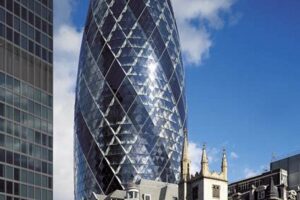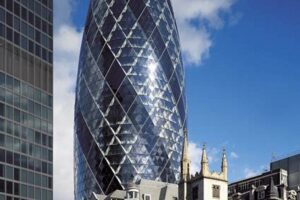London skyscrapers are tall buildings that dominate the skyline of London, England. They are a relatively recent phenomenon, with the first skyscrapers being built in the early 20th century. However, in recent years, there has been a boom in skyscraper construction in London, and the city is now home to some of the tallest buildings in Europe.
Skyscrapers are important for a number of reasons. First, they provide much-needed office space in a city where land is scarce. Second, they can be used to create iconic landmarks that become symbols of a city. Third, they can help to boost the economy by attracting businesses and tourists.
The history of London skyscrapers is closely linked to the city’s financial sector. In the early 20th century, London was one of the world’s leading financial centers, and the construction of skyscrapers was seen as a way to accommodate the growing number of banks and other financial institutions. The first skyscrapers in London were built in the City of London, the historic heart of the city’s financial district.
1. Height
The height of London skyscrapers is a defining characteristic that contributes to their significance and impact. As some of the tallest buildings in Europe, they have a commanding presence on the city’s skyline, symbolizing its economic power and ambition.
The height of these skyscrapers offers practical advantages as well. They provide ample space for offices, accommodating major corporations and financial institutions that drive London’s economy. Additionally, observation decks and rooftop bars in these skyscrapers offer breathtaking panoramic views, attracting tourists and locals alike, contributing to the city’s tourism industry.
Furthermore, the height of London skyscrapers presents engineering challenges that have been met with innovative solutions. Architects and engineers have employed advanced techniques to ensure structural integrity and sustainability, making these towering structures safe and resilient.
In conclusion, the height of London skyscrapers is not merely an aesthetic attribute but a key component that contributes to their economic, cultural, and engineering significance. Their towering presence has transformed London’s skyline, making it one of the most recognizable and dynamic in the world.
2. Architecture
The architecture of London skyscrapers is a captivating blend of diverse styles, ranging from modern to neoclassical. This architectural diversity reflects the city’s rich heritage and its position as a global hub.
- Modern Architecture: Modern skyscrapers in London, such as The Shard and Heron Tower, showcase sleek lines, geometric forms, and extensive use of glass. These structures epitomize contemporary architectural trends and contribute to the city’s cutting-edge image.
- Neoclassical Architecture: Neoclassical skyscrapers, such as 20 Fenchurch Street and The Admiralty Arch, incorporate elements of classical architecture, including columns, pediments, and symmetrical facades. These buildings evoke a sense of grandeur and historical continuity, blending seamlessly with London’s traditional streetscapes.
- Art Deco Architecture: Art Deco skyscrapers, such as One Aldwych and Broadcasting House, display geometric patterns, stylized ornamentation, and bold colors. These buildings represent the glamour and optimism of the early 20th century, adding a touch of sophistication to London’s skyline.
- Postmodern Architecture: Postmodern skyscrapers, such as Lloyd’s Building and 30 St Mary Axe, challenge conventional architectural norms with unconventional shapes, playful facades, and a mix of materials. These buildings reflect the experimental and eclectic spirit of postmodernism, adding a unique flavor to London’s architectural landscape.
In conclusion, the diverse architectural styles of London skyscrapers contribute to the city’s rich tapestry of built heritage. These iconic structures embody the evolution of architectural trends, showcasing the city’s modernity, historical roots, and cultural vibrancy.
3. Engineering
Engineering plays a critical role in the construction of London skyscrapers, ensuring their structural integrity and sustainability.
- Wind Engineering: London skyscrapers are subjected to strong winds, especially at high altitudes. Advanced wind engineering techniques, such as wind tunnels and computational fluid dynamics (CFD), are employed to analyze wind loads and design skyscrapers that can withstand these forces.
- Structural Engineering: The immense height and weight of London skyscrapers require innovative structural engineering solutions. Engineers use advanced materials, such as high-strength concrete and steel, and employ techniques like diagrid structures to distribute weight efficiently and ensure stability.
- Geotechnical Engineering: The foundation of London skyscrapers must be able to support their massive weight and withstand the unique geological conditions of the city. Geotechnical engineers conduct thorough soil investigations and design foundations that can prevent settling and ensure the long-term stability of these structures.
- Sustainability: Sustainability is a key consideration in the design of London skyscrapers. Engineers incorporate energy-efficient systems, such as double-glazed facades and rainwater harvesting, to reduce the environmental impact of these buildings.
In conclusion, advanced engineering techniques are essential for the construction of safe, sustainable, and iconic London skyscrapers. Engineers work collaboratively to overcome the challenges posed by height, wind, and geological conditions, ensuring that these towering structures can withstand the test of time and contribute to the city’s architectural legacy.
4. Views
London skyscrapers offer unparalleled views of the city from their observation decks. These vantage points provide a unique perspective on the city’s architecture, landmarks, and bustling streets. Here are some key aspects that highlight the connection between views and London skyscrapers:
- City Appreciation: Observation decks offer an elevated platform to appreciate the grandeur of London’s skyline. Visitors can identify iconic landmarks, such as Buckingham Palace and the Houses of Parliament, and gain a deeper understanding of the city’s geography.
- Tourism Magnet: Observation decks have become major tourist attractions in London. They offer a unique and memorable experience for visitors to capture the city’s beauty and create lasting memories.
- Architectural Showcase: Observation decks provide an opportunity to admire the architectural details of London skyscrapers up close. Visitors can observe the intricate designs, innovative facades, and sustainable features that contribute to the city’s architectural diversity.
- Sense of Place: The panoramic vistas from observation decks foster a sense of place and belonging among Londoners. They offer a shared vantage point to connect with the city’s past, present, and future.
In summary, the views from observation decks in London skyscrapers are not just breathtaking cityscapes but also valuable assets that contribute to tourism, architectural appreciation, and a sense of community. These vantage points enhance the experience of London, making it a truly vertical city.
5. Offices
Skyscrapers in London are not just architectural marvels; they are also vital hubs of commerce, housing major corporations and financial institutions. This connection has several key facets:
- Economic Significance: Skyscrapers play a crucial role in London’s economy. Major corporations and financial institutions, such as banks, insurance companies, and law firms, occupy significant spaces in these buildings. Their presence drives economic growth, generates employment opportunities, and contributes to the city’s overall prosperity.
- Global Connectivity: London is a global financial center, and its skyscrapers serve as hubs for international business. Companies based in these buildings have connections worldwide, facilitating trade, investment, and the flow of capital. This global connectivity enhances London’s position as a major player in the global economy.
- Innovation and Collaboration: Skyscrapers foster innovation and collaboration by bringing diverse businesses together under one roof. Companies can share ideas, access shared resources, and create synergies that drive economic growth. The close proximity of businesses in skyscrapers promotes networking and knowledge exchange.
In summary, the connection between offices and London skyscrapers goes beyond physical presence. These buildings are economic powerhouses, hubs for global connectivity, and catalysts for innovation, contributing significantly to the city’s economic vitality and global standing.
6. Landmarks
Notable skyscrapers, such as The Shard and Gherkin, have become iconic landmarks that embody the identity of London. This connection underscores the significance of these structures as symbols of the city’s architectural prowess, cultural heritage, and economic vitality.
The transformation of London skyscrapers into landmarks is attributed to several factors. Firstly, their unique and striking designs, often created by renowned architects, make them instantly recognizable and visually appealing. The Shard, with its distinctive shard-like form, and the Gherkin, with its futuristic shape, have become synonymous with London’s skyline. Secondly, these skyscrapers are often associated with important events or milestones in the city’s history, further solidifying their symbolic status. For example, The Shard was constructed as part of the London Bridge Quarter redevelopment project, symbolizing the regeneration of the area. Thirdly, the accessibility of these skyscrapers to the public, through observation decks or public spaces, allows visitors and locals alike to experience and connect with these architectural icons.
The recognition of London skyscrapers as landmarks has practical significance as well. It enhances the city’s tourism industry by attracting visitors eager to witness these architectural wonders. Additionally, these landmarks serve as orientation points, aiding navigation and creating a sense of place within the city’s vast urban landscape. Furthermore, the iconic status of these skyscrapers contributes to the city’s overall brand and image, making it a desirable destination for businesses, investors, and international recognition.
In conclusion, the connection between notable skyscrapers and London’s identity is undeniable. The architectural brilliance, historical significance, and public accessibility of these structures have transformed them into landmarks that symbolize the city’s character and contribute to its global appeal.
7. Tourism
Observation decks and rooftop bars perched atop London skyscrapers have become major tourist attractions, drawing visitors from around the globe. This connection underscores the significance of tourism as a vital component of London skyscrapers and the broader city experience.
The allure of these elevated vantage points lies in the unique experiences they offer. Observation decks, such as those found on The Shard, the London Eye, and the Sky Garden, provide breathtaking panoramic views of the city’s iconic landmarks, sprawling cityscape, and the winding River Thames. Rooftop bars, like those at the Gherkin, Aqua Shard, and Madison Rooftop Bar, combine stunning views with an unforgettable ambiance, offering a sophisticated and memorable way to experience London’s vibrant nightlife.
The economic impact of tourism associated with London skyscrapers is substantial. Visitors seeking these unique experiences contribute to the city’s hospitality industry, including hotels, restaurants, and transportation services. Moreover, the presence of observation decks and rooftop bars enhances the city’s reputation as a must-visit destination, attracting international travelers and boosting London’s global appeal.
Understanding the connection between tourism and London skyscrapers is crucial for urban planners, architects, and tourism operators. It informs the design and development of future skyscrapers, ensuring they incorporate accessible and visually captivating observation decks and rooftop spaces. Additionally, targeted marketing and promotional campaigns can leverage these unique experiences to attract visitors and showcase London as a dynamic and welcoming destination.
In conclusion, the connection between “Tourism: Observation decks and rooftop bars attract visitors seeking unique experiences.” and “london skyscrapers” is mutually beneficial. Observation decks and rooftop bars enhance the appeal of London skyscrapers, attracting tourists and contributing to the city’s economy. Recognizing and fostering this connection can help London maintain its position as a leading tourist destination and continue to offer unforgettable experiences for visitors worldwide.
FAQs About London Skyscrapers
Skyscrapers have become an iconic part of the London skyline, attracting attention and raising questions. Here are answers to some frequently asked questions about these architectural marvels:
Question 1: What is the tallest skyscraper in London?
Answer: The Shard, standing at 309 meters (1,016 feet), is the tallest skyscraper in London.
Question 2: How many skyscrapers are in London?
Answer: London has over 500 buildings classified as skyscrapers, with more under construction.
Question 3: What are the benefits of building skyscrapers?
Answer: Skyscrapers provide additional office space, create landmarks, boost the economy, and offer stunning views.
Question 4: Are London skyscrapers earthquake-proof?
Answer: While London is not in a major earthquake zone, skyscrapers are designed with advanced engineering techniques to withstand potential seismic activity.
Question 5: How do skyscrapers contribute to London’s identity?
Answer: Skyscrapers have become symbols of London’s financial power, architectural innovation, and global status.
Question 6: What are the environmental concerns surrounding skyscrapers?
Answer: Skyscrapers can impact energy consumption and contribute to urban heat island effects. However, modern buildings incorporate sustainable design features to mitigate these concerns.
In conclusion, London skyscrapers are architectural wonders that contribute to the city’s economic, cultural, and environmental landscape. Understanding these frequently asked questions provides a deeper appreciation for these iconic structures.
Transition to the next section: London’s Architectural Heritage
Tips for Exploring London Skyscrapers
To fully appreciate the architectural marvels that are London skyscrapers, consider these informative tips:
Tip 1: Visit Observation Decks:
Ascend to the observation decks of iconic skyscrapers like The Shard or the London Eye for unparalleled panoramic vistas of the city. Capture breathtaking photos and gain a new perspective on London’s vast urban landscape.
Tip 2: Explore Rooftop Bars:
Indulge in sophisticated ambiance and stunning views at rooftop bars perched atop skyscrapers. Sip cocktails while overlooking the city’s glittering skyline, creating unforgettable memories.
Tip 3: Learn the Architectural Styles:
London skyscrapers showcase diverse architectural styles. From the modern elegance of The Shard to the art deco grandeur of One Aldwych, take time to appreciate the unique design elements and historical influences that shape these buildings.
Tip 4: Consider Sustainability:
As skyscrapers continue to redefine London’s skyline, inquire about their sustainable features. Discover how these architectural giants incorporate energy-efficient systems, reduce environmental impact, and contribute to a greener city.
Tip 5: Respect Height Regulations:
London has strict height regulations for skyscrapers. Understand these limitations and appreciate the careful planning that goes into determining the height of each building, ensuring harmonious integration within the city’s architectural tapestry.
Tip 6: Attend Events and Exhibitions:
Stay informed about events and exhibitions hosted in London skyscrapers. From art installations to cultural gatherings, these events offer unique opportunities to experience these architectural wonders in a new light.
Tip 7: Seek Professional Guidance:
For a deeper understanding of London skyscrapers, consider guided tours led by architectural experts or historians. They can provide insights into the design, engineering, and historical significance of these remarkable structures.
Tip 8: Capture the Skyline:
Whether you’re an amateur photographer or a seasoned professional, capturing the iconic London skyline is a must-do. Experiment with different angles, lighting conditions, and vantage points to create captivating images that showcase the city’s architectural grandeur.
By following these tips, you can enrich your exploration of London skyscrapers, appreciate their architectural significance, and create lasting memories of your visit to this vibrant metropolis.
Conclusion
London skyscrapers, reaching towards the clouds, are architectural marvels that have transformed the city’s skyline and solidified its position as a global metropolis. Their diverse architectural styles, advanced engineering techniques, and iconic status have made them symbols of London’s economic power, cultural vibrancy, and unwavering ambition.
These towering structures not only provide essential office space and stunning views but also contribute to the city’s tourism industry and serve as landmarks that define London’s identity. As the city continues to grow and evolve, skyscrapers will undoubtedly play an integral role in shaping its future. They stand as a testament to human ingenuity, innovation, and the relentless pursuit of architectural excellence.







